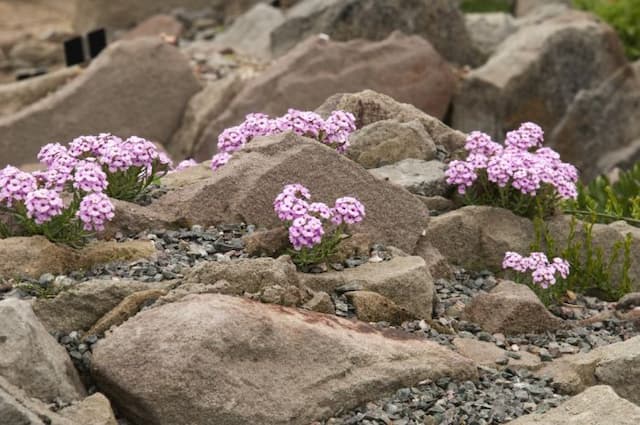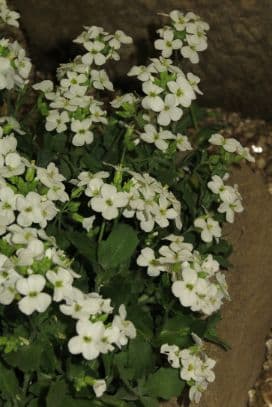Coast Rock Cress Arabis blepharophylla 'Rose Delight'

ABOUT
The Rose Delight, known for its delightful pink flowers, is a charming addition to any garden space. The plant sports deep green foliage that forms a low-growing rosette, creating a lush, carpet-like ground cover. Its leaves are typically oblong with a slight serration on the edges, contributing to its textured look. The most striking feature of the Rose Delight is its abundant pink blooms, which rise slightly above the foliage on slender stems. These flowers boast four delicate petals each, arranged in a cross shape, which is characteristic of its family. The petals exhibit a lively pink hue that can range from soft to bright tones, giving the plant its name 'Rose Delight.' The blossoms tend to cluster towards the top of the stems, creating a concentrated area of color, which contrasts beautifully against the green backdrop of the leaves. Blooming mainly in the spring, the flowers can catch the eye from a distance and are known to attract pollinators like bees and butterflies. The overall appearance of the Rose Delight exudes a cottage garden feel and provides a splash of color that can brighten up rockeries, borders, and container gardens alike.
About this plant
 Names
NamesFamily
Brassicaceae.
Synonyms
Coast Rock Cress, Rose Delight.
Common names
Arabis blepharophylla
 Toxicity
ToxicityTo humans
Coast rock cress is not known to be toxic to humans. There are no well-documented cases of poisonings or adverse effects from ingesting this plant. As with any non-food plant, it is generally recommended to avoid eating it as it may cause mild stomach upset or an allergic reaction in some individuals.
To pets
Coast rock cress is not known to be toxic to pets either. It is not listed as a toxic plant by major animal poison control resources, so it is unlikely to cause harm if ingested by pets. However, as with humans, ingestion of non-food plants can sometimes result in mild gastrointestinal upset, so it is still best to prevent pets from consuming plants not intended for them.
 Characteristics
CharacteristicsLife cycle
Perennials
Foliage type
Evergreen
Color of leaves
Green
Flower color
Pink
Height
0.75 feet [23 cm]
Spread
1 feet [30 cm]
Plant type
Herb
Hardiness zones
8
Native area
California
Benefits
 General Benefits
General Benefits- Attracts Pollinators: Arabis blepharophylla 'Rose Delight', also known as Coast Rockcress, attracts bees and butterflies, promoting pollination in the garden.
- Drought Tolerance: Once established, Coast Rockcress can tolerate periods of drought, making it ideal for water-wise landscaping.
- Low Maintenance: This plant requires minimal care, which is perfect for gardeners looking for easy-to-care-for plants.
- Ground Cover: It spreads effectively, providing a dense mat of foliage that helps suppress weeds and cover bare spots in the garden.
- Ornamental Flowers: The bright rose-pink flowers of 'Rose Delight' add color and visual interest to garden beds and borders in spring.
- Rock Gardens: Its compact size and ability to grow in rocky soil make it well-suited for rock gardens and alpine settings.
- Border Edges: With its mounding habit, it is ideal for creating defined edges along paths and flower beds.
 Medical Properties
Medical PropertiesThis plant is not used for medical purposes.
 Air-purifying Qualities
Air-purifying QualitiesThis plant is not specifically known for air purifying qualities.
 Other Uses
Other Uses- Coast Rock Cress can be used as a natural dye source for fabrics owing to its varied pigmentation, especially during the flowering phase.
- Due to its compact growth, it can be planted in crevices of garden walls or rockeries, adding aesthetic value with its foliage and flowers.
- It serves as an early-season nectar source for pollinators such as bees and butterflies before many other plants have started blooming.
- Coast Rock Cress can be used in container gardens to add variation in height and color, perfect for balcony or patio spaces.
- Its attractive leaves can be used as a background in pressed flower art, especially because they maintain their shape and color well when dried.
- When planted in mass, Coast Rock Cress can function as a living mulch, suppressing weeds and helping to retain soil moisture.
- This plant can be used in sensory gardens due to the textured leaves and the subtle fragrance of its flowers.
- For educational purposes, Coast Rock Cress can be grown to teach plant life cycles and reproductive biology in a school garden.
- Used as a ground cover, it can help prevent soil erosion on slopes thanks to its rooting system.
- Coast Rock Cress can be utilized in xeriscaping, a landscaping method that reduces or eliminates the need for supplementary water.
Interesting Facts
 Feng Shui
Feng ShuiThe Coast Rock Cress is not used in Feng Shui practice.
 Zodiac Sign Compitability
Zodiac Sign CompitabilityThe Coast Rock Cress is not used in astrology practice.
 Plant Symbolism
Plant Symbolism- Endurance: Arabis blepharophylla, commonly known as the Coast Rock Cress, often grows in harsh rocky environments, symbolizing the ability to endure difficult conditions and remain steadfast.
- Protection: The plant's natural habitat on rock faces and cliffsides where it serves as ground cover can represent a symbol of protection, as it often protects the soil from erosion.
- Beauty in Simplicity: With its modest, yet beautiful pink blooms, Coast Rock Cress can symbolize the idea of finding beauty in simple, unassuming places.
- New Beginnings: Often one of the first plants to bloom in spring, it can symbolize new beginnings and the renewal of life.
 Water
WaterCoast rock cress should be watered regularly, especially during dry spells, to keep the soil consistently moist but not soggy. A good rule of thumb is to water it once or twice a week, depending on the climate and soil drainage. Each watering session should provide enough water to moisten the soil to a depth of at least an inch. It's crucial to avoid overwatering, as this can lead to root rot. During the cooler months or in generally moist conditions, reduce the frequency of watering to prevent waterlogging.
 Light
LightCoast rock cress thrives in full sun to partial shade. It prefers a location that receives at least 6 hours of direct sunlight daily. Partial shade is beneficial in hotter climates to prevent the foliage from scorching. A spot that is bright and receives morning sunlight with some afternoon protection is ideal, especially in regions with very intense midday sun.
 Temperature
TemperatureCoast rock cress is hardy and can tolerate a range of temperatures; however, it does best in cooler conditions. It can survive minimum temperatures down to about 20 degrees Fahrenheit but prefers temperatures between 40 and 75 degrees Fahrenheit. Extreme heat can be detrimental, so if temperatures rise consistently above 75 degrees Fahrenheit, it's important to provide some shade to help cool the plant.
 Pruning
PruningCoast rock cress should be pruned to maintain shape, encourage bushier growth, and remove any dead or faded flowers. Pruning is best done after the plant has finished blooming, usually in late spring or early summer. Cut back the spent flower stalks and any leggy growth to promote a second flush of blooms and a denser foliage. Pruning about once a year is usually sufficient.
 Cleaning
CleaningAs needed
 Soil
SoilCoast Rock Cress prefers well-draining soil with a pH range of 6.0 to 7.5. A mix of potting soil, peat, perlite, and a small amount of sand or fine gravel works well to ensure good drainage and aeration. Adjusting pH might be necessary depending on the starting mix.
 Repotting
RepottingCoast Rock Cress should be repotted every 2 to 3 years or when it outgrows its current container, ensuring fresh soil and space for continued growth.
 Humidity & Misting
Humidity & MistingCoast Rock Cress tolerates a range of humidity levels but thrives best in moderate conditions; avoid excessively dry or highly humid environments.
 Suitable locations
Suitable locationsIndoor
Provide bright light and good air flow for Coast Rock Cress indoors.
Outdoor
Plant in partial sun, well-draining soil; water when topsoil feels dry.
Hardiness zone
5-9 USDA
 Life cycle
Life cycleArabis blepharophylla 'Rose Delight', commonly known as Coast Rock Cress, begins its life cycle as a seed, which upon encountering favorable conditions of moisture and temperature, germinates to form a seedling. The seedling grows into a rosette of basal leaves, establishing a root system. As the plant matures, it develops a flowering stalk that bears small pink or rose-colored flowers, typically blooming in early spring to late spring. After pollination, the flowers give way to fruit in the form of slender, elongated pods containing seeds. Once the seeds are released, they can disperse to start a new generation. In the right conditions, Coast Rock Cress can act as a perennial, surviving for several years, but it can also behave as an annual or biennial depending on the climate and growing environment.
 Propogation
PropogationPropogation time
Spring to Summer
Propogation: The Coast Rock Cress 'Rose Delight' is commonly propagated by seed. To successfully propagate by seed, wait until spring after the last frost when the soil temperature is comfortably warm for the seeds to germinate. Sow the seeds directly into the garden or into containers filled with well-draining soil mix, barely covering them with soil as they need light to germinate. Keep the soil consistently moist but not waterlogged. Germination typically occurs within two to three weeks. Once the seedlings have developed a couple of sets of true leaves, they can be thinned out or transplanted to their final positions, ensuring they are spaced adequately to allow for mature growth.



![Aubrieta [Axcent Light Blue]](/_next/image?url=https%3A%2F%2Fplants-admin.emdemapps.com%2Fimages%2Fplants%2F%2Fimages%2F604b5e7128866.png&w=640&q=75)





